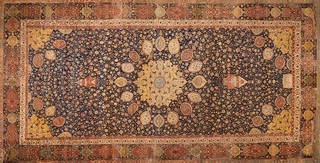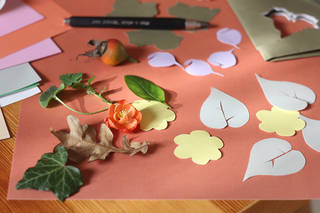Discover new shapes and patterns though our collection of Islamic art. Learn about symmetry and calligraphy, and design your own Islamic tile and tessellating pattern. Designed for ages 7 and up.
Islamic art is often found in Middle Eastern countries such as Iran, Egypt and Turkey. It celebrates design and creativity relating to the Muslim religion.
What are Islamic Patterns?
When making objects for mosques and other religious buildings, Muslim artists do not usually include people and animals. This is because it might look like people are praying to them, instead of to God. Instead artists often focus on rich colours, patterns, geometric shapes, plants and flowers.

These beautiful tiles come from Iran and are over 750 years old! Can you see the cross and eight-pointed star shapes? This arrangement of shapes can be repeated infinitely, over and over again, and is called a tessellating pattern.
The tiles are also symmetrical. If you drew a line down the middle of one of them, the pattern would be the same on each side. What symmetrical objects can you find around your house?

What is calligraphy?
Decorative writing, called calligraphy, is often used in Islamic art. It can be used for messages, to add a texture to an artwork, or to make it even more beautiful. The writing could be a poem, or might quote the Qur’an – the main religious text of Islam.

This is the Ardabil carpet, one of the biggest and finest carpets in the world. It is more than 5 meters wide and 10 meters long. The maker of the carpet has used calligraphy. A piece of poetry, a signature and the year it was made have been added in Persian. Can you see it written below?

There are many more examples of Islamic calligraphy in our collection.

Design your own Islamic tile
Now it’s time for you to design your own Islamic tile. For this activity you will need:
- Thick card or packaging, such as a cereal box
- A pencil and coloured pencils
- Coloured paper or magazines
- Scissors
- Glue
- Natural materials such as leaves, sticks or flowers

What to do:
1. Find some small leaves, sticks or flowers that you think have interesting shapes.
2. Put these objects on top of coloured paper or a page from a magazine. Draw around each object with your pencil.
3. Move your object to a different coloured sheet or magazine page and draw around it again. Repeat this several times.
4. Carefully cut all the shapes out, using scissors (with adult help if needed) and put them to one side.

5. Now you need to make a tile base out of card or a cereal box. It can be any shape you like. For inspiration, look back at the tile shapes you have seen already.
To ensure your tile has at least one line of symmetry, fold the card in half and cut out your shape. Then unfold it to see your creation. The more folds you do before cutting out the shape, the more lines of symmetry your tile will have.
6. Gather your colourful shapes from earlier. Start to arrange them on top of your new card tile base. Can you layer them so that there is a symmetrical pattern similar to the examples from the V&A’s collection? Can you also find space to draw your name in a decorative way, in the style of calligraphy, using coloured pencils?
7. When you’re happy with your design, use glue to stick down your cut-outs. You have just made an Islamic-inspired tile!

Design your own tessellating pattern print
For this activity you will need:
- Paper
- Pencil
- Scissors
- Any type of paint or ink, different colours if possible
- Potato or other firm root vegetable
- Knife (for an adult to cut the potato)
- An old plate, tub, or a paper plate
- Either card, cardboard (could be a cereal box or recycled packaging) or a piece of fabric

What to do:
1. Go on a hunt for shapes around your house. Find two interesting shapes that fit together – or tesselate – just like the cross and star tiles. If you need to, you can alter or simplify the shapes you find to make them tesselate.
2. Draw your tessellating pattern on a piece of paper to test if it works and can be repeated again and again.
3. Ask your adult to cut a medium sized potato in half. Then use a felt tip and draw your two shapes on the cut side of each half of the potato.
4. Ask your adult to cut out these shapes.
5. Pour some paint or ink into an old plate or tub.
6. Dip your potato slice shapes into the paint or ink, and press it onto the paper or fabric to print your shape.
7. Now try to use another shape that fits with your first shape and print it next to it with a different colour.
8. Repeat this process as many times as you can.

Share your Islamic art inspired designs with us using #VAMFamilies


